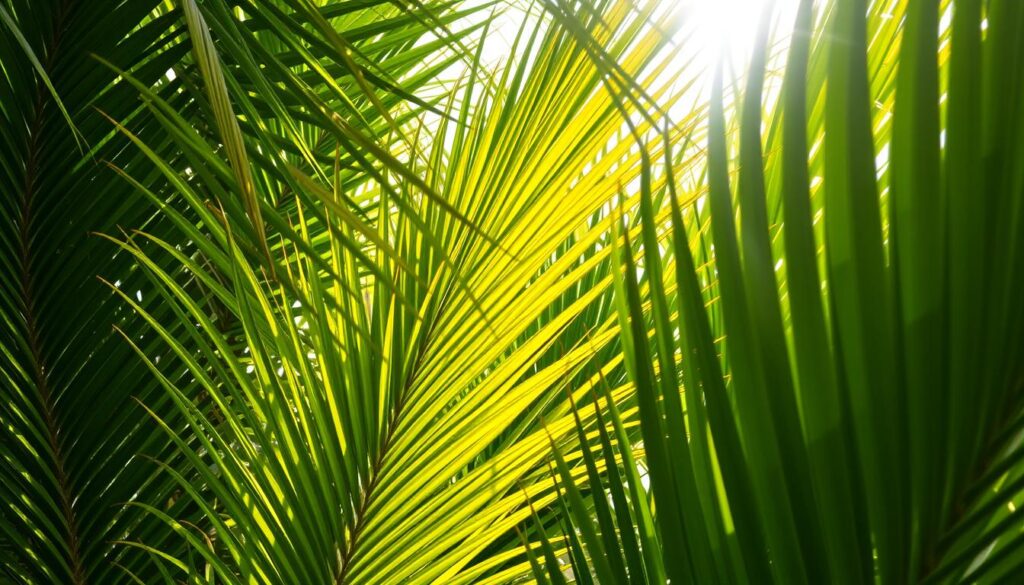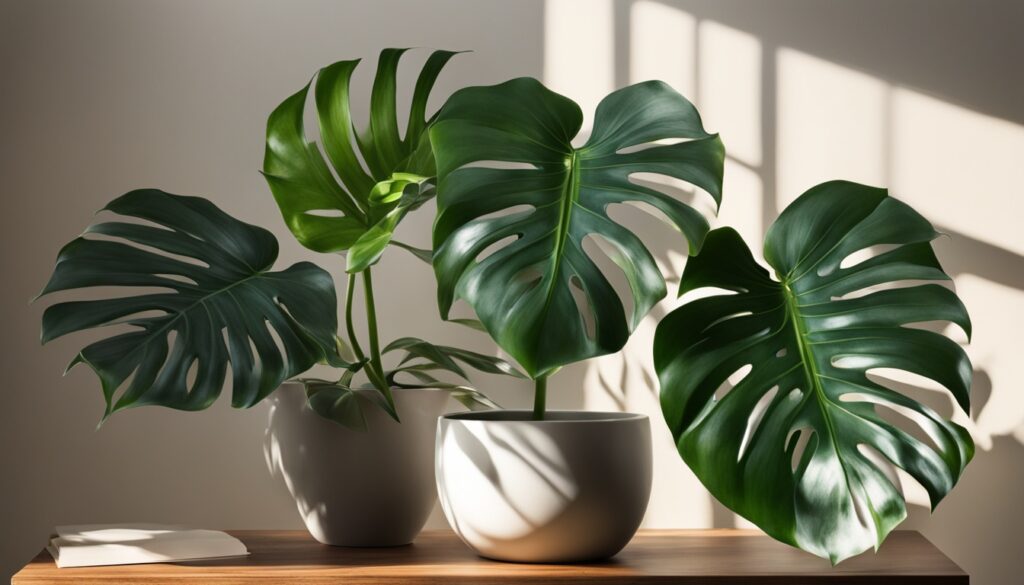Do you wonder why your palm leaves are turning yellow? This change can be a worry, but it usually means there’s a simple fix. We’ll explore the main reasons for yellow leaves and show you how to make your palm trees green and healthy again.
Key Takeaways
- Palm trees are evergreen plants that should maintain green fronds year-round.
- Yellow leaves can be a sign of natural aging or indicate underlying issues like nutrient deficiencies, pests, or diseases.
- Proper palm tree care, including balanced fertilization, adequate watering, and pest management, can prevent and address yellow leaf issues.
- Identifying the root cause of yellowing leaves is crucial for implementing effective treatment and restoration strategies.
- Consulting with a professional arborist or horticulturist can help diagnose and resolve complex palm tree health problems.
Understanding Palm Trees as Evergreen Plants
Palm trees are a unique and captivating part of the natural landscape. They are known for their distinct fronds and stately silhouettes. Many people don’t know that palm trees are classified as evergreen plants. This means they should stay green all year.
As these trees grow, older fronds naturally turn yellow and fall off. This usually starts at the bottom of the tree. But, if palm leaves keep turning yellow, it could mean there’s a problem that needs fixing.
Natural Growth Patterns of Palm Trees
Palm trees have a natural growth cycle. Older fronds shed and make room for new, vibrant growth. This is a normal part of their life cycle and shouldn’t worry you.
As a palm tree gets older, the lower fronds turn yellow and drop off. This lets the plant focus on growing new, green foliage at the top.
The Importance of Year-Round Green Fronds
Keeping palm trees green is key for their health and beauty. If evergreen palms have yellow or brown leaves, it might mean there’s a problem. This could be a lack of nutrients, pests, diseases, or stress from the environment.
Fixing these issues quickly can help the palm tree stay healthy and vibrant. It will continue to be a stunning addition to any landscape.
Understanding how palm trees grow and the importance of their green leaves helps us care for them better. By taking good care of them and watching for any problems, we can keep our evergreen palms healthy and beautiful for years.
Proper palm tree care and watching for any signs of trouble are key. This way, we can enjoy the beauty of these trees in our landscapes.
Why Are My Palm Leaves Turning Yellow
If your palm leaves are turning yellow palm fronds, there could be several reasons. Palm trees often face issues like nutrient deficiencies, wrong watering, pests, and diseases. Finding out why is key to fixing your palm tree.
Nutrient shortages, especially nitrogen, manganese, or magnesium, can turn leaves yellow. Too much or too little water can also cause yellow palm fronds. Pests and diseases can harm the leaves, leading to palm leaf discoloration.
- Do a soil test to find out if nutrients are off balance.
- Check how often you water and adjust to keep the soil right.
- Look for pests or diseases on your palm tree and treat them.
- Use a balanced, slow-release fertilizer to feed your palm tree.
Fixing the problem can make your palm tree green and healthy again. This ensures it stays strong and beautiful for a long time.
“Palm trees have become an iconic feature of Sarasota’s residential landscapes due to their aesthetic appeal and resilience.”
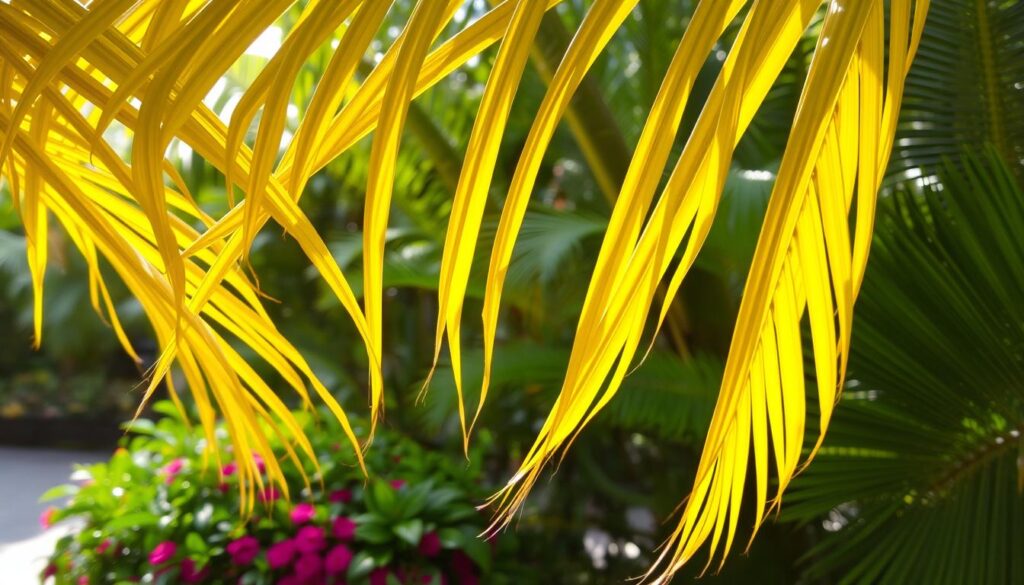
Remember, taking good care of your palm tree is crucial. If you’re not sure what to do, talk to a local arborist or palm tree care expert.
Natural vs. Problematic Yellow Palm Fronds
Not all yellow leaves on your palm tree mean trouble. Palms naturally shed older, lower fronds as they grow. This yellowing and dropping of leaves is part of the tree’s aging process.
Signs of Natural Leaf Aging
The oldest, bottom fronds often turn yellow as the tree grows. It sheds these leaves to make room for new growth at the top. This is a normal part of a palm’s life cycle.
Warning Signs of Underlying Issues
But, if new leaves turn yellow, it might be a bigger problem. Yellowing leaves could mean nutrient issues, pests, diseases, or watering problems. These signs need quick attention to fix the tree’s health.
Watching your palm tree closely helps you know when it needs help. Regular checks and quick action can prevent and fix palm frond yellowing.
“Proper care and attention can make all the difference in the world for the health and longevity of your palm tree.”
Common Nutrient Deficiencies in Palm Trees
Nutrient deficiencies often cause yellowing palm leaves. Knowing what nutrients palm trees need is key to keeping them healthy and looking good. Important nutrients include nitrogen, potassium, magnesium, manganese, and boron.
Nitrogen deficiency is a common problem, causing fronds to turn yellow. Nitrogen deficiency often happens in palms that have been recently transplanted.
Potassium deficiency leads to yellow spots on fronds. This is common in palms in Florida’s sandy soils. Symptoms include frond discoloration, necrotic streaks, and frond death.
Magnesium deficiency causes a light-yellow band along frond margins with green centers. It affects the tree’s look. This issue is seen in Phoenix canariensis palms in Florida, often due to bad fertilization.
Manganese deficiency affects new fronds, causing them to curl, crinkle, and grow slowly. This happens in alkaline soils and many palm species.
Boron deficiency is less common but still affects palm health. It causes crumpled fronds, hook-leaf syndrome, and other issues in young palms.
Regular soil tests and proper fertilization are vital to prevent and fix these nutrient deficiencies. By keeping the right balance of nutrients, palm owners can keep their trees healthy and looking great.
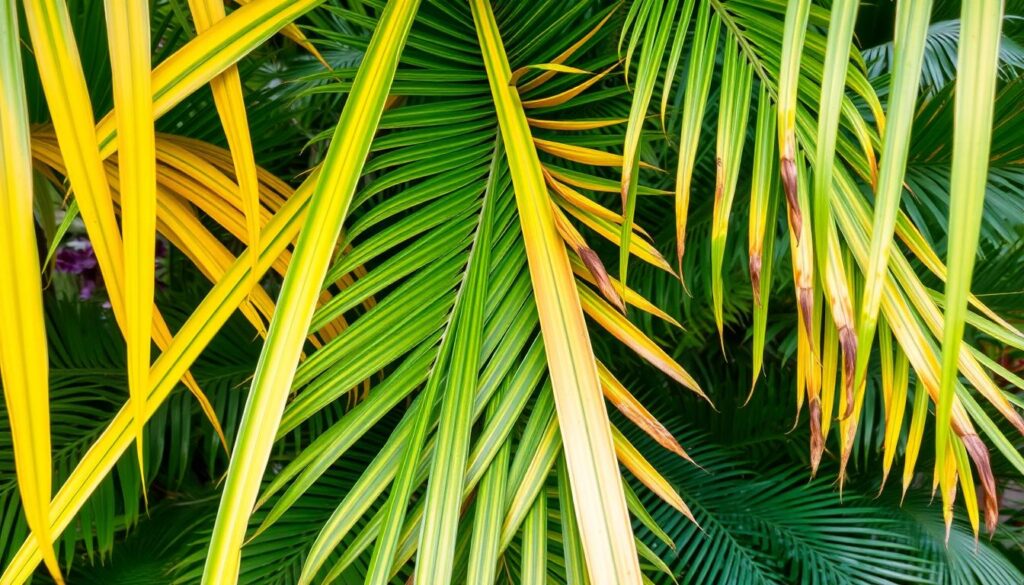
“Proper palm tree fertilization is crucial for maintaining their health and preventing nutrient deficiencies.”
The Impact of Nitrogen Deficiency on Palm Health
Nitrogen deficiency is a common problem that affects palm trees. This essential nutrient is key for palm fronds to grow well. Without it, palm trees show clear signs that gardeners need to know.
Symptoms of Low Nitrogen
One key sign of nitrogen deficiency is yellowing older fronds. This starts at the tips and moves to the base. As the problem gets worse, new fronds also turn yellow, making the whole palm look yellow-green.
Also, nitrogen-deficient palms grow slower and seem less healthy than others.
Solutions for Nitrogen Deficiency
- To fix nitrogen deficiency, use a slow-release fertilizer made for palms. These fertilizers give palms a steady flow of nitrogen, keeping the soil nutrient-rich.
- It’s important to fertilize palms regularly, about 3-4 times a year. This keeps nitrogen levels right and helps palms stay healthy.
Knowing the signs of nitrogen deficiency and acting early helps palms stay green and healthy. Keeping up with fertilization is key to avoiding this problem.
“Proper fertilization is crucial for addressing nutrient deficiencies and maintaining palm health.”
Magnesium and Manganese: Essential Palm Nutrients
Keeping palm trees healthy means balancing their nutrients well. Magnesium and manganese are two important ones. A lack of these can cause yellowing in palms.
Magnesium shortage shows as yellow tips on leaves. Manganese shortage makes leaves yellow between veins. This can be deadly if not fixed. High pH soils make it hard for palms to get these minerals.
| Nutrient | Deficiency Symptoms | Recommended Solutions |
|---|---|---|
| Magnesium | Bright yellow tips on fronds | Apply Magnesium sulfate (Epsom salts) |
| Manganese | Yellowing between leaf veins | Foliar or media applications of Manganese sulfate |
| Iron | Sprinkled green dots, overall chlorosis, or longitudinal yellow stripes | Adjust soil pH, use acidic fertilizers, apply Iron Sulfate and elemental sulfur |
To meet palm nutrient needs, use the right fertilizers and adjust soil pH. Regular soil tests can spot magnesium deficiency in palms or other imbalances. This helps keep your palms healthy and thriving.
“Identifying and addressing nutrient deficiencies is crucial for the long-term success of palm trees, as they can significantly impact their growth and appearance.”
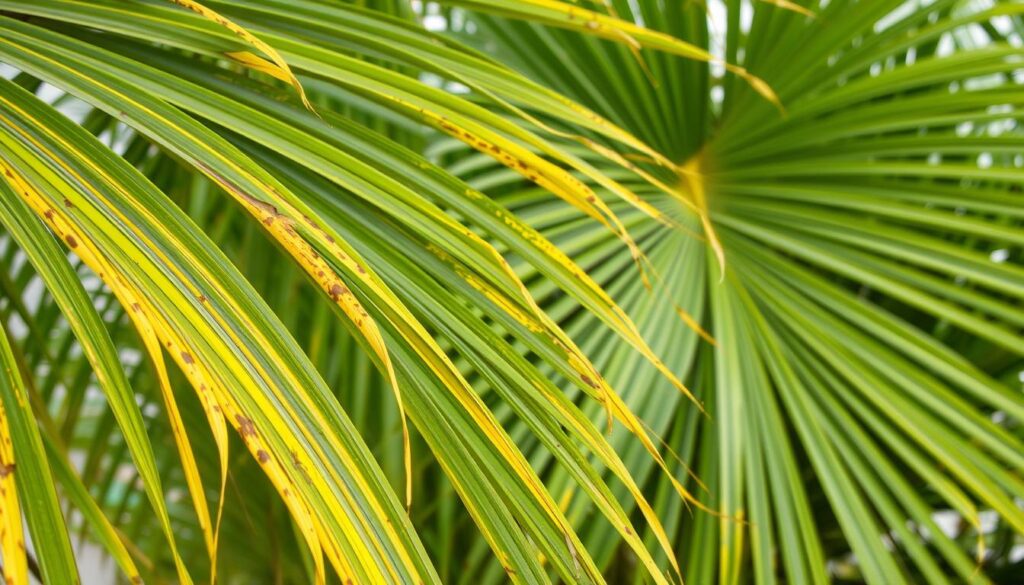
Soil Requirements for Healthy Palm Trees
Keeping the soil right is key for palm trees to do well. These plants love soil that drains well and is full of nutrients. The best mix for palm trees is a mix of organic matter and sand. This mix helps prevent water from pooling and keeps roots healthy.
Optimal Soil Composition
Palm trees do best in slightly acidic to neutral soil, with a pH of 6.0 to 7.0. This pH helps them get the nutrients they need, like nitrogen and iron. It’s a good idea to test the soil often, especially for fast-growing palms like Queen and Majesty palms.
pH Balance Requirements
While most palms like slightly acidic to neutral soil, some need more moisture and nutrients. For example, Majesty and Queen palms grow fast in rich, moist soil. Keeping an eye on the palm tree soil pH and adjusting it when needed helps prevent problems.
“Proper soil preparation and maintenance are essential for the long-term success of palm trees. Neglecting the soil’s needs can lead to a range of issues, from yellowing leaves to stunted growth and even premature decline.”
Knowing what soil palm trees need and keeping it right helps them stay healthy and vibrant. Gardeners and landscapers can keep their palm trees looking great for many years by following these tips.
Watering Issues Leading to Yellow Palm Leaves
Getting the water balance right is key for palm trees to stay healthy and look great. Both overwatering and underwatering can cause yellow leaves. This means there’s a problem that needs fixing.
Too much water can rot the roots, making leaves turn yellow and fall off early. This happens when the soil stays too wet, often because of bad drainage or too much watering. On the flip side, not enough water can make the leaf tips brown and crispy. This is because the plant can’t get enough moisture.
Palm trees usually need 30-44 inches of water each year to grow well. The exact amount depends on the palm type, its age, and the local weather. New palm trees might need to be watered twice a week for the first 2-3 months until they settle in.
- Make sure the soil drains well to avoid waterlogging and root rot.
- Change how often you water based on the palm type, its age, and the weather.
- Check the soil moisture and water when the top few inches feel dry.
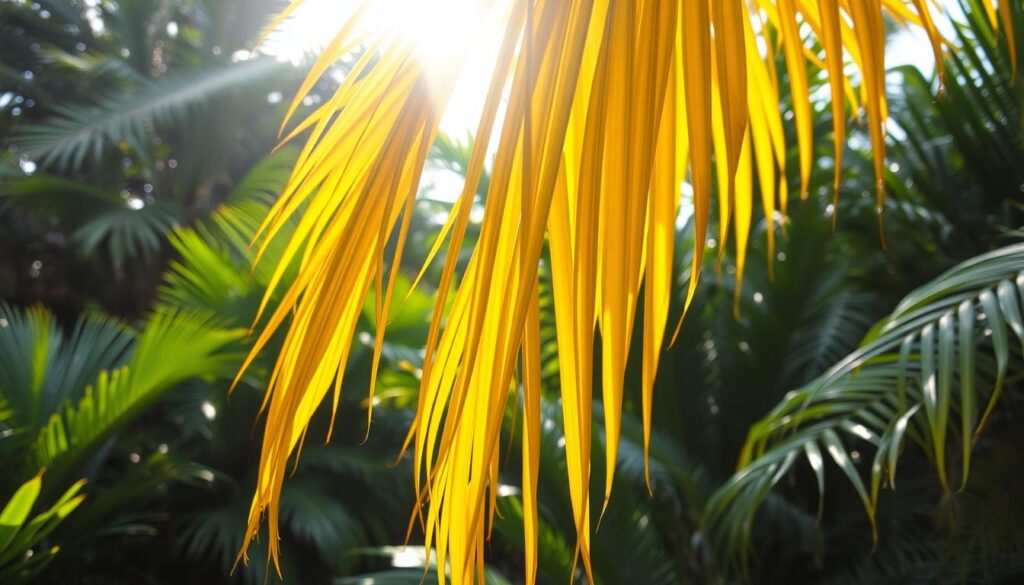
Fixing watering problems and keeping the right moisture can stop yellow leaves. Remember, finding the right balance is crucial. Too much or too little water can harm your palm trees’ health and look.
Pest Infestations Affecting Palm Health
Palm trees face many pests that can turn their leaves yellow. Spider mites, mealybugs, and palm aphids are common pests. They feed on the palm’s moisture, causing the leaves to yellow and wilt.
Common Palm Tree Pests
- Spider mites: These tiny arachnids spin fine webs on the undersides of leaves, leading to stippling and discoloration.
- Mealybugs: These sap-sucking insects leave behind a sticky residue on fronds, further hampering the palm’s health.
- Palm aphids: These small, soft-bodied insects can infest the new growth, causing it to become distorted and yellow.
Signs of Pest Damage
Spotting pests early is key for palm tree pest control. Look for webs, sticky residue, and visible insects on fronds. These signs mean your palm needs help.
“Pest infestations can quickly spiral out of control if left unchecked, leading to severe damage and potentially the demise of your palm tree.”
Using the right insecticides or natural remedies is vital for your palms’ health. Regular checks and quick action keep your palms vibrant and pest-free.
Fungal Diseases in Palm Trees
Palm trees are loved for their lush fronds and tropical look. But, they can get sick from fungal diseases. These diseases can turn their leaves yellow and make them wither.
Common fungal problems include leaf-spotting fungi and the serious Ganoderma root rot. Symptoms include droopy fronds, root decay, and spotted leaves. These problems can harm the tree’s health and look. Good air flow, not too much, and keeping the tree healthy are key to fight these diseases.
In bad cases, you might need to use fungicides or cut off sick parts. Getting a certified arborist to check the tree often can help catch problems early. This way, you can stop them from getting worse.
| Common Fungal Diseases Affecting Palm Trees in Texas | Symptoms |
|---|---|
| Ganoderma Butt Rot | Wood decay, trunk and root rot |
| Fusarium Wilt | Wilting, yellowing, and death of fronds |
| Pink Rot | Pink or reddish-brown discoloration of fronds |
| Diamond Scale | White, waxy scales on leaves and trunks |
| Leaf Spot Diseases | Discolored, spotted leaves |
Keeping the soil right, fertilizing well, and treating fungal problems fast can help palm trees stay healthy. By watching for palm diseases and fungal infections in palms early, you can keep your palms looking good and strong.
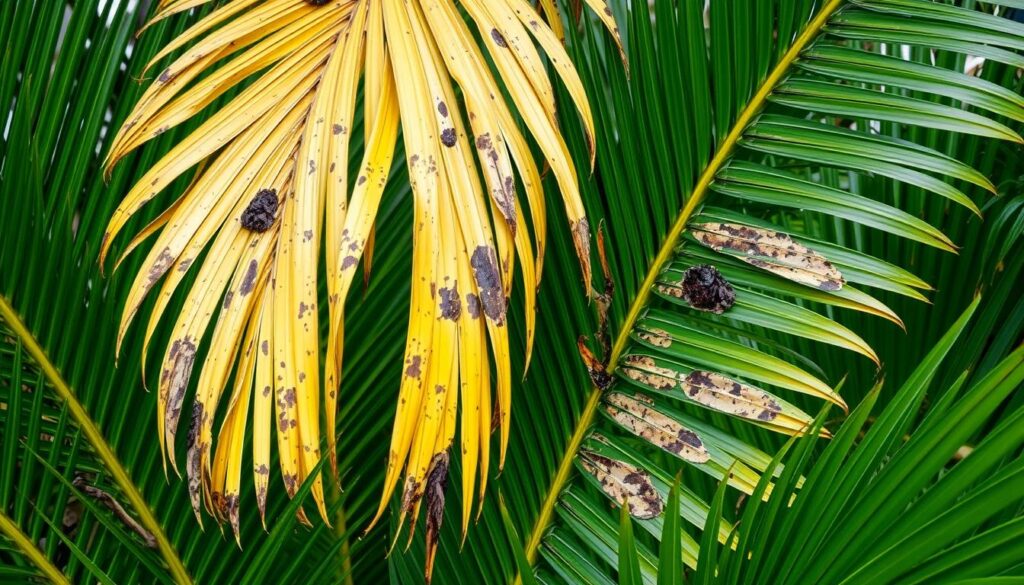
“Healthy palms are less prone to fungal infections and can better withstand environmental stresses.”
Special Care for Queen and Majesty Palms
Queen and Majesty palms need special care to thrive. They love soil that’s rich in moisture and nutrients. They also need more fertilizer than other palms.
Unique Nutritional Needs
These palms need a lot of nitrogen, phosphorus, and potassium. They need 3-4 fertilizer applications per year. Use a slow-release formula made for palm trees.
It’s important to test the soil and check the pH often. This helps keep them healthy and prevents yellow leaves.
Maintenance Requirements
They prefer soil that drains well and has organic matter like coco coir. Repot them when they double in size or every year. This gives them fresh soil and nutrients.
Watering is key. Majesty palms need about 0.5 cups of water every 9 days when potted and not in direct sunlight.
Knowing how to care for Queen and Majesty palms is crucial. With the right Queen palm care and Majesty palm maintenance, these palms can be beautiful additions to your garden.
Proper Palm Tree Fertilization Schedule
It’s key to have a good fertilization plan to keep palm trees healthy. Most palms do well with 3-4 fertilizations a year. This is best done in early spring, summer, and fall. Use a slow-release palm tree fertilizer that has the right mix of nutrients.
Queen and Majesty palms need more food, so they should be fertilized 3-4 times a year. Other palms might only need it once a year. Always check with a certified arborist or do soil tests to find the best palm tree fertilization plan for your trees.
Using the right amount of fertilizer at the right time is crucial. Good palm tree fertilization keeps leaves green, supports strong roots, and prevents yellow leaves. This is due to nutrient deficiencies.
| Palm Tree Species | Fertilization Schedule | Nutrient Requirements |
|---|---|---|
| Queen Palm | 3-4 times per year | Moisture-rich, nutrient-dense soil |
| Majesty Palm | 3-4 times per year | Moisture-rich, nutrient-dense soil |
| Other Palm Varieties | 1-2 times per year | Balanced, well-draining soil |
For palm trees to thrive, a balanced and consistent palm fertilizer schedule is essential. By following these guidelines and getting professional advice when needed, your palm trees will stay lush and healthy all year.
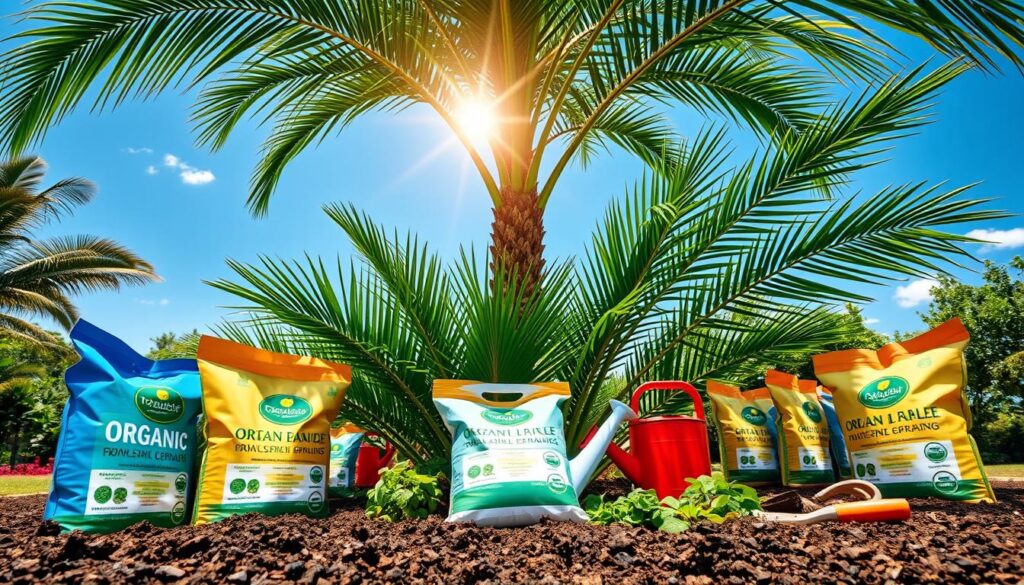
When to Prune Yellow Palm Fronds
Pruning yellow palm fronds needs care and should only be done when needed. Remove only dead, brown fronds at the base. Don’t cut yellow fronds that are still green, as it can worsen nutrient issues.
Correct Pruning Techniques
Proper pruning of palm trees means using sharp tools and making cuts close to the trunk. It’s vital to make clean cuts to help the tree heal and prevent pests or diseases. Always clean your tools before and after use to keep them effective and prevent infections.
Timing of Frond Removal
The right time to remove palm fronds is important. Prune in the spring or summer, when the tree is growing. This lets the tree heal before winter. Don’t prune in fall or winter, as it can stress the tree and make it more vulnerable to disease or damage.
| Pruning Recommendation | Optimal Timing |
|---|---|
| Removal of Dead, Brown Fronds | Year-Round, as Needed |
| Removal of Partially Green, Yellowing Fronds | During the Growing Season (Spring/Summer) |
| Disinfection of Pruning Tools | Before and After Each Use |
By following these best practices for palm frond pruning and palm tree trimming, you can keep your palm trees healthy and looking good. This ensures they will thrive for many years.
“Proper pruning is essential for the long-term health and vitality of palm trees. Timing and technique are key to ensuring a successful outcome.”
Prevention Strategies for Yellow Palm Leaves
Keeping your palm trees healthy is the first step to stop yellow leaves. Start by testing the soil often and giving the right nutrients through [palm tree maintenance]. It’s also important to water them right – too much water can cause yellow and brown leaves.
Make sure your palms get enough sunlight exposure and air around their leaves. Having a regular maintenance schedule helps spot problems early. This way, you can fix them before they turn into yellow leaves.
- Watch for pests that can make leaves turn yellow.
- Keep palms safe from extreme temperatures and direct sunlight to prevent scorching.
- Think about adding fertilizer if your palms need more nutrients like nitrogen and magnesium.
By being careful and following the right steps, you can keep your palm trees looking green and healthy for a long time.
| Potential Causes | Preventive Measures |
|---|---|
| Overwatering | Use a moisture meter to check soil moisture and let the top inch dry out before watering again. |
| Nutrient Deficiencies | Test the soil regularly and fertilize as needed, especially for nitrogen and magnesium. |
| Pest Infestations | Check your palms often for pests and deal with them quickly. |
| Environmental Stress | Keep palms away from direct sunlight, extreme temperatures, and bad air circulation. |
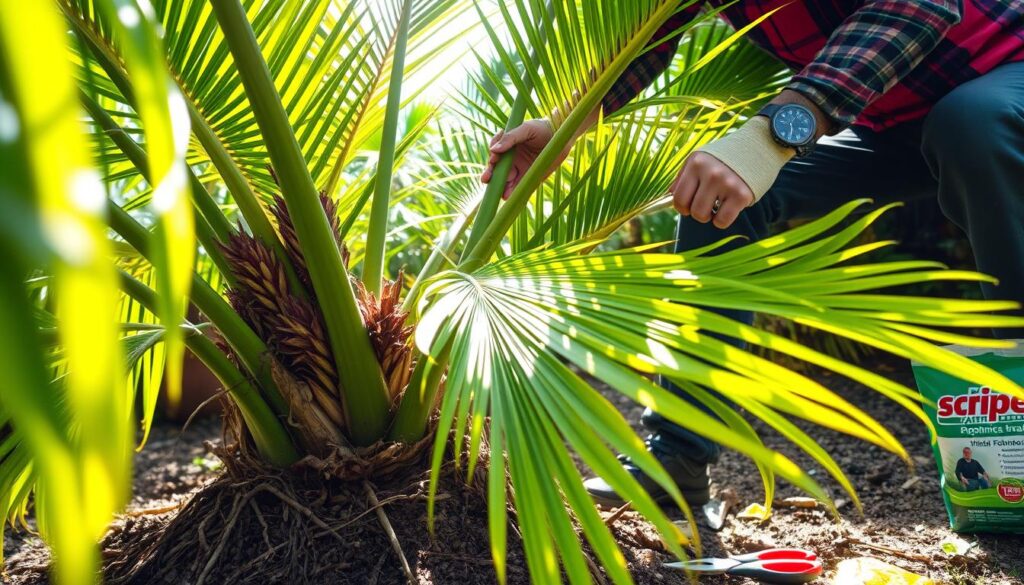
“Maintaining the overall health of your palm trees is key to preventing yellow palm leaves.”
Professional Palm Tree Care and Treatment
When you face tough palm tree problems or DIY fixes don’t work, a certified palm tree arborist is your best bet. These experts know how to care for palm trees. They help keep your landscape’s palm trees healthy and vibrant.
A skilled palm care pro will check your palm trees thoroughly. They find any hidden issues and suggest the right fixes. They can do soil tests, pick the best fertilizers, and handle pests or diseases that make leaves turn yellow.
Choosing a certified arborist means your palm trees are in good hands. These pros have the skills and tools to give your palms the care they need. They handle everything from pruning to keeping pests away, making sure your palms stay green and healthy.
Getting professional palm tree care might be the answer to your yellow leaf problems. With a certified expert, you can be sure your palms are safe. They’ll keep your outdoor space looking great for years.
“A healthy, thriving palm tree is a true testament to the beauty and resilience of nature. With the right professional care, your palms can reach their full potential and enhance the overall aesthetic of your property.”
Whether it’s nutrients, pests, or diseases, a certified palm tree arborist has the answers. Letting a seasoned pro take care of your palms ensures they stay healthy. This keeps your outdoor space looking lush and tropical.
Conclusion
To keep palm trees healthy and green, it’s important to know why their leaves turn yellow. Problems like not getting enough nutrients, too much or too little water, pests, and diseases can harm them. Fixing these issues is key to keeping palm trees looking their best.
By taking good care of palm trees, like giving them the right food and checking the soil, you can keep them looking great. Regular checks and quick action when problems show up are essential. This helps keep palm tree health in top shape and prevents yellow leaves.
With the right care, palm trees can stay healthy and add beauty to any outdoor area. Knowing what palm trees need and fixing problems fast helps them thrive. This way, you can enjoy the lush, green leaves that make a tropical oasis feel real.
